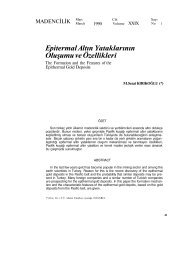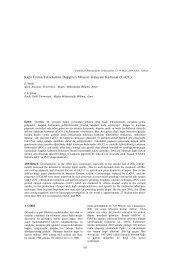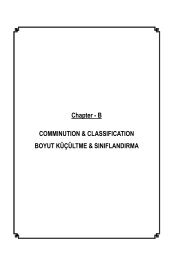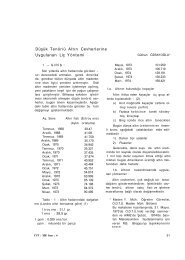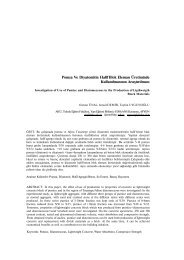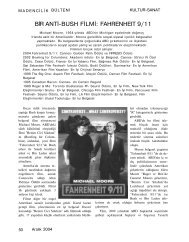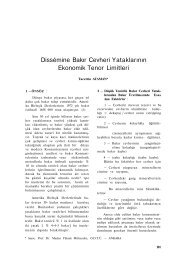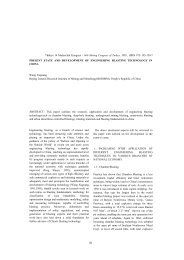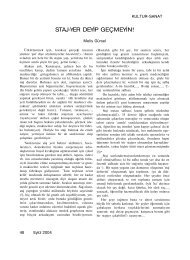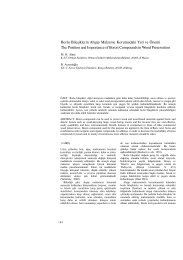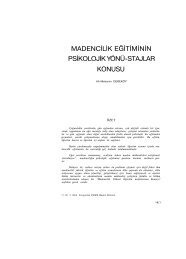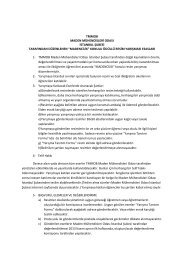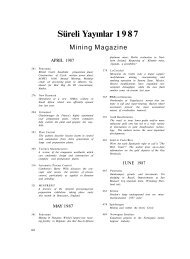A OPEN PIT MINING AÇIK OCAK MADENCİLİĞİ
A OPEN PIT MINING AÇIK OCAK MADENCİLİĞİ
A OPEN PIT MINING AÇIK OCAK MADENCİLİĞİ
You also want an ePaper? Increase the reach of your titles
YUMPU automatically turns print PDFs into web optimized ePapers that Google loves.
23 rd <br />
Ultimate Pit Limit Design on Base of Sustainable Development<br />
Criteria<br />
N. Adibee, M. Ataeepour<br />
Amirkabir University of Technology (Tehran Polytechnic), Tehran, Iran<br />
ABSTRACT Sustainable development is the concept that plays important role in business<br />
and industry of the 21st century. In recent years, the concept of sustainability and sustainable<br />
development has been successfully extended to mineral resources, but there are few attempts<br />
to consider this concept in the Ultimate Pit Limit (UPL) design. The determination of UPL is<br />
the first step in the open pit mine design and planning process. There are several<br />
mathematical, heuristic and meta-heuristic algorithms to determine UPL. The optimization<br />
criterion in these algorithms is the maximization of total profit. Few models integrate some<br />
aspects of mining reclamation benefit and cost in the UPL design. However, there is not any<br />
comprehensive method for UPL design on base of sustainable development consideration.<br />
This paper provides a model for UPL designing based on sustainable development criteria.<br />
Based on this model, it is possible to integrate the sustainable development issues in UPL<br />
design.<br />
1 INTRODUCTION<br />
The main issue in design of open pit mines is<br />
that of determining the optimum ultimate pit<br />
limit (UPL) of a mine. Based on common<br />
definition, the UPL of a mine is that contour<br />
which is the result of extracting the volume<br />
of material, which provides the total<br />
maximum profit whilst satisfying the<br />
operational requirement of safe wall slopes.<br />
The ultimate pit limit gives the shape of the<br />
mine at the end of its life. Optimum pit<br />
design plays a major role in all stages of the<br />
open pit life such as feasibility study stage,<br />
operating phase and end of a mine’s life. The<br />
UPL problem has been efficiently solved<br />
using the Lerchs-Grossmann graph theoretic<br />
algorithm or Picard’s network flow method.<br />
These methods are based on the “block<br />
model” of an orebody.<br />
Determination of UPL on base of profit<br />
maximization does not coincide with<br />
sustainable development issues. However, if<br />
one tries to consider sustainable<br />
development in the UPL determination, he<br />
must take into account the other aspects of<br />
sustainable development other than<br />
economic aspects.<br />
In 1987, the Bruntland Commission<br />
defined the sustainable development as a<br />
“system of development that meets the basic<br />
needs of all people without compromising<br />
the ability of future generations to meet their<br />
own life-sustaining needs” (United Nations,<br />
1987). In the mine design, "sustainable<br />
development" is used since interchangeably<br />
with "environmental management" or<br />
"environmental protection". In such cases,<br />
there is the propensity to resolve only one<br />
type of problem — environmental<br />
deterioration — while ignoring the<br />
importance of economic and social goals,<br />
two equally important pillars of sustainable<br />
development [Hilson, 2000]. For example<br />
Burgher and Erickson (1984) showed how,<br />
105



